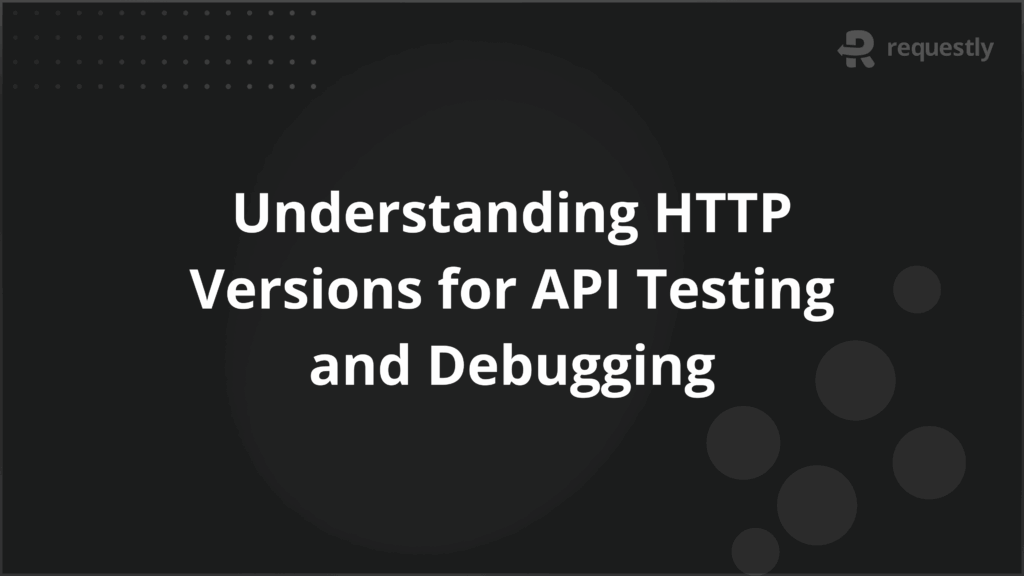Understanding HTTP Versions for API Testing and Debugging


HTTP defines how clients and servers exchange data. The version in use affects request handling, connection management, encryption, and overall API performance. For testers, this means that each version introduces different behaviors to validate, new points of failure to debug, and specific configuration checks to perform.
This article explains what HTTP is, different HTTP versions, how those differences affect API communication, and the practical steps for checking, upgrading, and managing them.
What is HTTP?
HTTP, or Hypertext Transfer Protocol, is the foundation of communication between clients and servers. It defines how requests for data are sent from a client, such as a browser or API client, and how servers respond with the requested information.
At its core, HTTP works as a request-response protocol:
- The client sends a request specifying the resource, method, headers, and optionally a body.
- The server processes the request and returns a response containing a status code, headers, and a body.
Below are the main elements that define HTTP communication:
- Methods: Define the type of action, such as GET, POST, PUT, DELETE, or PATCH.
- Headers: Carry metadata about the request or response, like content type, authentication tokens, or caching rules.
- Body: Contains the actual data being sent or received, such as JSON, XML, or form data.
- Status Codes: Indicate the result of a request, including success (200), client errors (4xx), or server errors (5xx).
These elements remain consistent across versions, but how they are handled and transmitted evolves with each HTTP version.
Understanding HTTP Versions
HTTP has evolved to handle increasing demands for speed, reliability, and security in web and API communication. Each version changes how requests and responses are structured, how connections are managed, and how data is transmitted.
HTTP/0.9
HTTP/0.9, released in 1991, was the first version of the protocol. It was extremely simple, designed solely to fetch HTML documents from servers. Requests used only the GET method and consisted of a single line specifying the resource path.
There were no headers, status codes, or metadata. The server returned the raw content immediately and closed the connection after sending the response. This version did not support multiple methods, content types, or error handling.
Core Features of HTTP/0.9:
- Only GET requests are supported
- No request or response headers
- No status codes
- Returned raw HTML or plain text
- Single request per TCP connection; no persistent connections
Testing focus is on verifying basic connectivity and raw content retrieval. This version is rarely used today, but understanding it helps explain the origin of headers, status codes, and multiple methods.
HTTP/1.0
HTTP/1.0, introduced in 1996, added structured metadata and support for multiple request methods. Requests could include headers like Content-Type or Authorization, and responses included standard status codes (200, 404, 500).
Each request opened a new TCP connection because persistent connections were not standard. Caching existed but was inconsistent across servers and clients.
Core Features of HTTP/1.0:
- Support for GET, POST, and HEAD methods
- Request and response headers for metadata
- Standard status codes for success and error handling
- Each request required a new TCP connection
- Basic caching through headers such as Expires
Testing requires validating headers, status codes, and content types. Connection handling can impact performance, so repeated requests need checks for latency and timeout behavior.
HTTP/1.1
HTTP/1.1, standardized in 1999, improved efficiency, connection management, and caching. Connections became persistent by default, allowing multiple requests over the same TCP session.
Chunked transfer encoding enabled servers to stream data without knowing the full content length. Additional methods (PUT, DELETE, OPTIONS, TRACE) were introduced. Caching and content negotiation became more structured, and host headers allowed multiple domains to operate on a single IP.
Core Features of HTTP/1.1:
- Persistent connections by default
- Chunked transfer encoding for streaming responses
- Additional methods: PUT, DELETE, OPTIONS, TRACE
- Structured caching headers: Cache-Control, ETag, Vary
- Host headers for multiple domains on a single IP
Testers need to check connection reuse, streaming behavior, caching, and proper handling of pipelined requests. Concurrent request handling should also be validated.
HTTP/2
HTTP/2, published in 2015, focused on reducing latency and improving performance. It switched from text-based to binary framing, making parsing faster and more reliable.
Multiplexing allows multiple requests and responses to share a single TCP connection without blocking each other. Header compression (HPACK) reduces redundant metadata, and servers can prioritize streams. Server push enables resources to be sent to clients before explicit requests, improving performance for certain workflows.
Core Features of HTTP/2:
- Binary protocol instead of text
- Multiplexing multiple requests/responses over one connection
- Header compression (HPACK) to reduce overhead
- Stream prioritization for efficient resource handling
- Server push to send resources proactively
Testing must ensure clients handle multiplexed streams correctly, headers are compressed and decompressed properly, request prioritization works as expected, and pushed resources do not break API logic.
HTTP/3
HTTP/3 uses QUIC over UDP instead of TCP. This reduces connection setup time and improves resilience to packet loss. It maintains features like multiplexing and header compression while allowing faster recovery from network interruptions.
Zero-round-trip resumption enables repeat connections with minimal latency. Integrated security combines transport and encryption, and the protocol avoids TCP head-of-line blocking.
Core Features of HTTP/3:
- Uses QUIC over UDP for faster, more resilient connections
- Multiplexing multiple streams without head-of-line blocking
- Header compression and stream prioritization
- Zero-round-trip connection resumption
- Built-in security combining transport and encryption
Testers must validate connection establishment, session resumption, behavior under packet loss or network jitter, and ensure APIs handle multiplexed streams correctly without errors.
Why HTTP Versions Matter
Each HTTP version introduces technical changes that affect how APIs behave and how testers must approach validation. Differences in connection handling, data framing, header processing, caching, and security directly influence testing strategies, debugging accuracy, and performance assessment.
Understanding HTTP versions helps design realistic test scenarios and anticipate version-specific issues.
- Connection behavior: HTTP/1.0 opens a new TCP connection per request, HTTP/1.1 uses persistent connections, HTTP/2 multiplexes streams, and HTTP/3 uses QUIC over UDP. Testers must verify that multiple simultaneous requests, session reuse, and connection resilience behave as expected.
- Data transmission: Binary framing in HTTP/2 and UDP-based QUIC in HTTP/3 changes how requests and responses are packaged. Tests must validate correct parsing, proper handling of chunked or multiplexed data, and integrity of streamed payloads.
- Headers and metadata: Compressed headers in HTTP/2/3 reduce overhead but can cause errors if clients misinterpret them. Testers need to confirm that authentication tokens, caching directives, and custom headers are transmitted correctly.
- Performance and latency: Multiplexing, server push, and connection resumption affect response times. Test scenarios should simulate high concurrency, repeated requests, and network variability to measure throughput and latency accurately.
- Error handling: Differences in protocol behavior influence the handling of timeouts, dropped packets, and partial responses. Testers must ensure APIs respond correctly under these conditions and that retry logic functions as intended.
- Security and compatibility: Integrated encryption in HTTP/3 and evolving TLS requirements mean testers must validate secure connections, certificate handling, and backward compatibility with older clients or intermediaries.
Comparing HTTP Versions
This table shows how each HTTP version handles connections, methods, headers, caching, and performance.
Feature | HTTP/0.9 | HTTP/1.0 | HTTP/1.1 | HTTP/2 | HTTP/3 |
Connection Behavior | Single request per TCP; no persistence | New TCP per request | Persistent connections; pipelining | Multiplexed streams over one connection | QUIC over UDP; no head-of-line blocking |
Supported Methods | GET only | GET, POST, HEAD | GET, POST, HEAD, PUT, DELETE, OPTIONS, TRACE | Same as HTTP/1.1 | Same as HTTP/2 |
Headers & Metadata | None | Basic headers | Structured headers (Host, Cache-Control, ETag) | Compressed headers (HPACK) | Compressed headers (HPACK) |
Data Transmission | Raw HTML/text | Text-based | Chunked transfer | Binary framing | Binary over QUIC |
Caching & Compression | None | Limited caching (Expires) | Standard caching, content negotiation | Compressed headers, efficient caching | Compressed headers, efficient caching |
Performance & Latency | Very slow for multiple requests | Slower due to repeated connections | Improved throughput, less handshake overhead | Lower latency, better prioritization | Faster setup, resilient under packet loss |
Testing Focus | Connectivity and response retrieval | Headers, status codes, connection timeouts | Connection reuse, streaming, caching, concurrent requests | Multiplexing, header compression, server push | Connection setup, 0-RTT resumption, packet loss, encrypted streams |
How HTTP Versions Affect API Communication
The way each HTTP version manages requests, responses, and connections changes how APIs behave. For testers, this determines what needs to be validated during debugging and performance checks. The main areas of impact are:
1. Request Handling
HTTP/1.0 requires a new connection per request, HTTP/1.1 reuses persistent connections, HTTP/2 supports multiplexing, and HTTP/3 leverages QUIC to avoid head-of-line blocking. Each requires different validation of latency, stream management, and connection reuse.
2. Response Delivery
Early versions focused on plain payloads, while HTTP/1.1 introduced caching and chunked transfer. HTTP/2 and HTTP/3 added binary framing and header compression, requiring testers to verify cache directives, streaming behavior, and compression accuracy.
3. Performance Considerations
Version differences affect latency, throughput, and reliability. For example, repeated TCP setup in HTTP/1.0 causes delays, while multiplexing in HTTP/2 reduces latency. Testers benchmark across versions to identify bottlenecks and compatibility gaps.
How to Check and Upgrade HTTP Version
Testers must follow a clear process to verify the current version, check compatibility, and ensure performance stays consistent after an upgrade. Here are the steps to check and upgrade HTTP version:
Step 1: Identify the current version
Open the browser developer tools, go to the Network tab, and check the Protocol column to see which HTTP version the API or website is using.
Step 2: Verify server and client compatibility
Confirm that the server software (Nginx, Apache, etc.) supports the target version, and ensure client libraries, SDKs, or proxies can handle it without errors.
Step 3: Upgrade the server configuration
Enable HTTP/2 or HTTP/3 modules, update TLS settings, and adjust connection parameters where required.
Step 4: Run regression and performance tests
Validate endpoint behavior across all supported versions, benchmark response times, and test multiplexing, caching, and compression under load.
Step 5: Monitor after deployment
Track logs, latency, and error rates to detect version negotiation problems or unexpected performance regressions.
Common Issues and Solutions When Using HTTP Versions
Each HTTP version introduces new behaviors, and with those come issues that testers need to account for. Problems often arise during version negotiation, performance benchmarking, or security validation.
1. Version negotiation problems
A frequent issue is that the client and server fail to agree on the same HTTP version. In such cases, connections either fall back to HTTP/1.1 or fail altogether. This creates misleading results, for example when a test meant for HTTP/2 actually runs on HTTP/1.1.
The solution is to confirm the negotiated version during every test. Browser developer tools or API clients with protocol logging can help testers verify the active protocol.
2. Unexpected performance gaps
Although HTTP/2 and HTTP/3 are designed for faster data transfer, testers sometimes see little or no improvement. This usually occurs when multiplexing is not enabled, servers are not tuned, or middleboxes interfere with the connection.
Performance benchmarks must therefore validate whether the environment actually uses the features of the newer protocol. If not, optimization on the server or network path may be required before meaningful results can be observed.
3. Compatibility issues with legacy systems
Some proxies, firewalls, or monitoring tools still do not fully support HTTP/2 or HTTP/3. This leads to connection resets, dropped requests, or incomplete logs. For API testers, this complicates debugging and makes error patterns harder to detect.
The practical solution is to test with and without such intermediaries, confirm end-to-end protocol support, and use fallback strategies if critical components lack compatibility.
4. Security gaps during upgrade
Each protocol version introduces new security considerations. For example, HTTP/2 multiplexing can be abused for DoS attacks, and HTTP/3 relies on QUIC which may not be fully inspected by traditional firewalls.
Testers need to check how security controls behave under the new protocol and whether logging tools capture the required details. Running controlled negative tests, such as sending malformed requests, helps validate that the system remains resilient.
Why Use Requestly for HTTP Version Management
Requestly by BrowserStack is a lightweight tool that helps testers control and inspect network traffic directly in the browser or within automated setups. Instead of relying only on curl commands or server logs, testers can use Requestly to handle HTTP version checks and modifications with less effort. Here are the core actions it enables:
- Modify requests and responses: Adjust headers or payloads to test how APIs behave under different HTTP versions without touching production code.
- Check active protocols: Identify whether traffic is using HTTP/1.1, HTTP/2, or HTTP/3 directly within the tool.
- Share consistent rules: Distribute HTTP version configurations across teams so that everyone tests under the same conditions.
- Integrate into workflows: Add HTTP version checks into CI pipelines or run them directly within browser developer tools.
Conclusion
HTTP versions define how data is transferred across the web, and each HTTP version changes how requests and responses are handled, which directly impacts latency, reliability, error reporting, and security. For testers, this means validating how APIs behave under different versions and ensuring upgrades do not introduce regressions
Requestly makes this process easier by giving testers the ability to intercept traffic, enforce specific versions, and inspect request–response flows in real time. With these capabilities, teams can replicate real-world conditions, confirm stability during migrations, and gain confidence that APIs deliver consistent performance across HTTP versions.

Contents
- What is HTTP?
- Understanding HTTP Versions
- HTTP/0.9
- HTTP/1.0
- HTTP/1.1
- HTTP/2
- HTTP/3
- Why HTTP Versions Matter
- Comparing HTTP Versions
- How HTTP Versions Affect API Communication
- How to Check and Upgrade HTTP Version
- Common Issues and Solutions When Using HTTP Versions
- Why Use Requestly for HTTP Version Management
- Conclusion
Subscribe for latest updates
Share this article
Related posts























